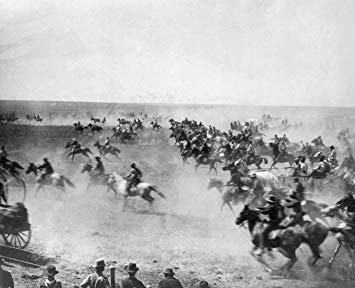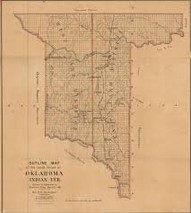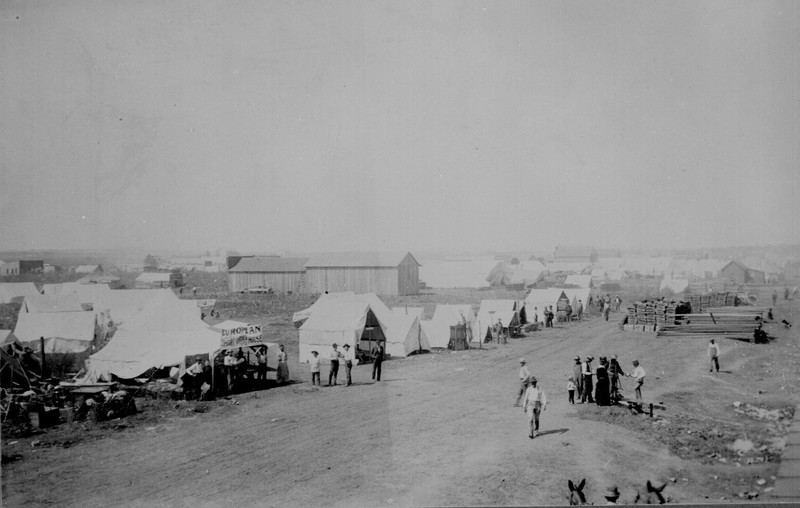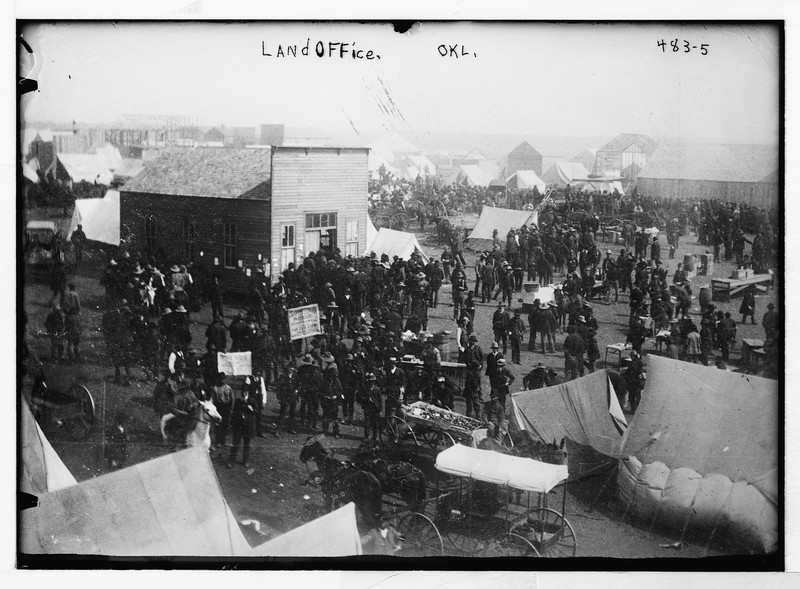Land Rush of 1889
Introduction
Text-to-speech Audio
The Land Rush of 1889 is one of the largest settlement initiatives into "Unassigned Lands" in western history. Made possible by the Indian Appropriation Acts, the 1889 Land Rush took place in modern Canadian, Kingfisher, Logan, Oklahoma, and Payne counties. On the day of the land rush, April 22nd, 1889 an estimated 50,000 people participated. Of those estimated participants 10,000 would claim plots of land around a rail road station called Deer Creek. This mass of people would be the first settlers of a town that would be later named Guthrie. Guthrie became the first capital of the Oklahoma Territory and later the capital of Oklahoma.
Images
Land Rush participants "rush" to find their ideal plot of land. A fifth of which would settle around modern day Guthrie, OK.

A map of the land that was up for claiming.

"Tent Cities" that popped up on the first day of the Land Rush. This is Guthrie, OK on April 22nd, 1889.

The U.S. land office in Guthrie, OK. During the 1889 Land Rush people came to these offices to claim their land stakes.

Backstory and Context
Text-to-speech Audio
The Land Run of 1889 was the first land rush into the “Unassigned Lands”. The land run provided for an acceleration for the settlement of the Western Frontier and signified the culmination of Anti-Native American rhetoric. The land in question was part of the present day counties: Canadian, Kingfisher, Logan, Oklahoma, and Payne.
The land rush began on April 22nd, 1889 with an estimated 50,000 people participating. The rush effectively created towns in a single day with Guthrie being the best example. Guthrie would go on to become the Capital of the Oklahoma Territory and later the Capital of the State of Oklahoma. The title of State Capital would be moved to Oklahoma City after a 1910 vote.
The land rush began on April 22nd, 1889 with an estimated 50,000 people participating. The rush effectively created towns in a single day with Guthrie being the best example. Guthrie would go on to become the Capital of the Oklahoma Territory and later the Capital of the State of Oklahoma. The title of State Capital would be moved to Oklahoma City after a 1910 vote.
The Indian Appropriations Act of 1889 was a series of acts surrounding the Native American land which made the 1889 Land Rush legally, and politically possible. The Appropriations Act consists of the 1851, 1871, 1885, and 1889 Act. The final 1889 Act opened Unassigned Lands to white settlers under the Homestead Act, thus resulting in the Land Rush.
The 1889 Act also coined the term “Boomer” and "Sooners". "Boomers" are the people who attempted to enter unassigned lands before the Indian Appropriations Act of 1889. "Sooners" refer to people who went into the Unassigned Lands before the Land Rush officially began. This is where the University of Oklahoma’s fight song, “Boomer Sooner” comes from.
One of the most famous "Boomers" and the arguable founder of the Boomer movement was David Payne who capitalized on the the demand for land in "Unassigned Land" territories. Payne moved into the "Unassigned Lands" and settled the town of Ewing in 1879. Ewing would eventually become what we know as Oklahoma City. David Payne would sell off plots of land illegally to other members of the Boomer movement. Later in April of 1979 President Rutherford B. Hayes issued the proclamation forbidding unlawful entry into the Indian Territory until the Land Rush of 1889, 10 years later.
The 1889 Act also coined the term “Boomer” and "Sooners". "Boomers" are the people who attempted to enter unassigned lands before the Indian Appropriations Act of 1889. "Sooners" refer to people who went into the Unassigned Lands before the Land Rush officially began. This is where the University of Oklahoma’s fight song, “Boomer Sooner” comes from.
One of the most famous "Boomers" and the arguable founder of the Boomer movement was David Payne who capitalized on the the demand for land in "Unassigned Land" territories. Payne moved into the "Unassigned Lands" and settled the town of Ewing in 1879. Ewing would eventually become what we know as Oklahoma City. David Payne would sell off plots of land illegally to other members of the Boomer movement. Later in April of 1979 President Rutherford B. Hayes issued the proclamation forbidding unlawful entry into the Indian Territory until the Land Rush of 1889, 10 years later.
Sources
https://archive.nytimes.com/www.nytimes.com/learning/general/onthisday/big/0422.html#article
https://www.okhistory.org/publications/enc/entry.php?entry=EI002
https://library.okstate.edu/okmaps/
Everett, Dianna. Encyclopedia of Oklahoma History and Culture. "Enabling Act (1906)." Retrieved January 10, 2012
